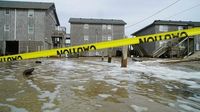Hurricane Erin, a colossal storm stretching across more than 600 miles, churned up dangerous waves and battered the U.S. East Coast on August 21, 2025, leaving a trail of high surf, closed roads, and battered dunes—but, remarkably, sparing coastal communities from widespread destruction. As the storm began a slow march out to sea, its effects rippled from North Carolina’s Outer Banks all the way to New England, with forecasters warning that the threat of rip currents and coastal flooding would linger into the weekend.
According to the Associated Press, Erin remained a Category 2 hurricane on Thursday afternoon, boasting maximum sustained winds of around 100 mph (160 kph) and swirling roughly 420 miles east-northeast of Cape Hatteras. The National Hurricane Center (NHC) emphasized that, despite the storm’s gradual weakening, its sheer size—twice that of an average hurricane—meant that its impacts were felt far beyond its center. Tropical-storm-force winds extended nearly 480 miles from the eye, and the storm’s outer bands lashed barrier islands, low-lying beaches, and even the bustling shores of New York and New Jersey.
For North Carolina’s Outer Banks, the story was one of both resilience and vulnerability. The barrier islands, essentially sand dunes perched a few feet above sea level, faced waves estimated as high as 18 feet (5.5 meters) on Thursday morning. Local weather reports and drone footage captured by The Weather Channel showed the dramatic overwash as waves broke through dunes on Hatteras and Ocracoke islands, closing vital stretches of Highway 12—the area’s main artery—and severing Ocracoke’s connection to its ferry terminal. The North Carolina Department of Transportation reported that major overwash and dune breaches left deep sand, water, and debris covering key roadways.
Despite the dramatic images, Dare County Manager Bobby Outten told the Associated Press that the worst fears of new inlets forming—potentially isolating communities—had not materialized. "All in all, it’s not as bad as it could have been," Outten said. "Hopefully the worst of it is behind us." The Hatteras Island Rescue Squad, a volunteer group based in Buxton, confirmed that it received no calls for rescues from the night of August 20 into the morning of August 21. Still, the battered dunes and scarred beaches told a story of significant coastal erosion, with the next high tide threatening to wash over areas already weakened by the storm.
Environmental impacts extended beyond infrastructure. The Emerald Isle Sea Turtle Patrol reported that waves from Erin had washed away multiple sea turtle nests in the Outer Banks. State conservation guidelines prevented volunteers from digging up the nests, and North Carolina does not have the facilities to house them all. The group urged the public to steer clear of the affected areas, noting that the eggs might yet survive the washout if left undisturbed.
Elsewhere along the coast, the storm’s reach was unmistakable. Beaches were closed to swimming in New York City, and New York Governor Kathy Hochul ordered several state beaches on Long Island to prohibit swimming for the day. Several New Jersey beaches also remained off limits due to dangerous rip currents and high surf. As New Jersey Governor Phil Murphy put it, "Enjoy the shore, enjoy this beautiful weather but stay out of the water." According to The Weather Channel, lifeguards stood watch along deserted beaches, while authorities worked to keep the public safe from the hidden dangers lurking beneath the waves.
Not everyone stayed away from the water, though. At Rockaway Beach in Queens, more than a dozen surfers braved the surf, undeterred by the official closures. Scott Klossner, a local resident, told the Associated Press, "You wait all year round for these kinds of waves. It’s challenging, really hard to stay in one place because there’s a heavy, heavy, heavy rip. But this is what surfers want—a hurricane that comes but doesn’t destroy my house? I’ll take that."
Further north, the storm’s effects were also felt in New England. Waves up to 15 feet (4.5 meters) were forecast to roll into the coasts of Nantucket Island and Martha’s Vineyard, and high winds were expected to persist into Friday morning. Meteorologists from The Weather Channel noted that the anticyclonic motion of high-level cirrostratus clouds, visible from Mount Washington in New Hampshire, signaled efficient ventilation of the tropical cyclone—a reminder of the storm’s vast atmospheric footprint.
In New Jersey, the winds from Erin toppled trees and power lines in Fair Lawn, forcing road closures and sending cleanup crews into action. The annual East Coast Surfing Championships in Virginia Beach suspended its heats for the day, with organizers planning to rebuild the competition setup once conditions improved. Footage from Brant Beach, New Jersey, and as far north as Nantucket, Massachusetts, showed rolling surf and high tide impacts, underscoring the storm’s broad influence.
Residents and visitors along the coast remained on alert as forecasters warned of more flooding during high tide on the evening of August 21. The National Oceanic and Atmospheric Administration (NOAA) provided real-time tidal information, helping communities prepare for the next surge. According to senior meteorologist Jonathan Erdman of The Weather Channel, "This evening’s high tide is the one where flooding may be greatest from North Carolina to the Jersey shore, as northeast winds from soon departing Hurricane Erin keep pushing water to the coast."
Amid the storm, life went on for some. On Jennette’s Pier in Nags Head, where sustained winds reached 45 mph (72 kph), locals and visitors alike watched the spectacle of nature unfold. Photographer David Alan Harvey remarked, "This is nature at her best. I love this. I love these storms." Nearby, Sebastian Kettner cast his line into the churning surf, undaunted by the weather: "Where there’s water, there’s fish. And there’s a lot of water here."
Satellite images from NOAA’s GOES East Satellite captured a striking view of Erin as it began to pull away from the coast, its swirling clouds and massive wind field a testament to its power. The NHC continued to monitor three additional tropical disturbances far out in the Atlantic, a reminder that hurricane season was far from over.
For many, Hurricane Erin’s passage was a test of preparation and resilience. Advances in forecasting allowed meteorologists and emergency managers to track the storm for nearly two weeks, giving residents ample time to make decisions and avoid panic. As The Weather Channel observed, the impacts were largely expected and prepared for, and the lack of catastrophic damage was a testament to both nature’s unpredictability and human readiness.
As Erin moves further out to sea, the battered but largely intact communities of the East Coast breathe a sigh of relief—grateful for the reprieve, but ever mindful of the power nature can unleash.




